AES New York 2018
Paper Session P07
P07 - Perception – Part 2
Thursday, October 18, 9:30 am — 12:00 pm (1E12)
Chair:
Hyunkook Lee, University of Huddersfield - Huddersfield, UK
P07-1 Reproducing Low Frequency Spaciousness and Envelopment in Listening Rooms—David Griesinger, David Griesinger Acoustics - Cambridge, MA, USA
Envelopment – the perception of being surrounded by a beautiful acoustic space – is one of the joys of concert halls and great recordings. Recording engineers strive to capture reverberation independently in each channel, and reverberation from digital equipment is similarly non-coherent. But in playback rooms with a single low frequency driver or a single subwoofer reverberation is often flat, frontal, and without motion. In this paper we will show that full range loudspeakers or at least two independent subwoofers can bring low frequency envelopment back to a playback room. In some rooms minimizing room modes with high pressure at the listening position while maximizing lateral modes with minima near the listeners can help. If necessary, we put two independent subwoofers at the sides of the listeners.
Convention Paper 10063 (Purchase now)
P07-2 Evaluation of Implementations of the EBU R128 Loudness Measurement—Brecht De Man, Birmingham City University - Birmingham, UK
The EBU R128 / ITU-R BS.1770 specifications are widely followed in various areas of the audio industry and academic research. Different implementations exist in different programming languages with subtly differing design parameters. In this work we assess these implementations on their performance in terms of accuracy and functionality. As filter equations are notably absent from the standard, we reverse engineer the prescribed filter coefficients and offer more universal filter specifications. We also provide a simple implementation of the integrated loudness measure in JavaScript, MATLAB, and Python.
Convention Paper 10064 (Purchase now)
P07-3 Hyper-Compression in Music Production: Testing the “Louder Is Better” Paradigm—Robert W. Taylor, University of Newcastle - Callaghan, NSW, Australia
Within the scope of the literature surrounding the Loudness War, the “louder is better” paradigm plays a cornerstone role in the motivation and also presumed justification for the continued use of hyper-compression. At the core of this assumption is the non-linearity of frequency response of the human auditory system first identified by Fletcher and Munson [11]. Previous research into listener preferences concerning hyper-compression has attempted to rationalize this production practice with audience expectations. The stimuli used in these studies have invariably been loudness normalized to remove loudness bias in audition so that only the perceptual cues of dynamic range compression (DRC) are under examination. The results of these studies have proven less than conclusive and varied. The research study presented herein examines the extent of influence the “louder is better” paradigm has on listener preferences via a direct comparison between listener preference tasks that present music that is loudness normalized and music that retains the level differentiation which is a by-product of the hyper-compression process. It was found that a level differential of 10 dB had a significant influence of listener preferences as opposed to the arguably weak perceptual cues of DRC.
Convention Paper 10065 (Purchase now)
P07-4 The Effect of Pinnae Cues on Lead-Signal Localization in Elevated, Lowered, and Diagonal Loudspeaker Configurations—Wesley Bulla, Belmont University - Nashville, TN, USA; Paul Mayo, University of Maryland - College Park, MD, USA
In a follow-up to AES-143 #9832, this experiment employed a novel method that altered subjects’ pinna and examined the effects of modifying salient spectral cues on time-based vertical-oriented precedence in raised, lowered, and diagonal sagittal and medial planes. As suggested in the prior study, outcomes confirm perceptual interference from acoustic patterns generated via lead-lag signal interaction. Results provide clear physical and psychophysical evidence that reliable elevation cues may be rendered ineffective by stimuli such as those used in typical precedence-based experiments. Outcomes here demonstrate the salient and powerful influence of spectral information during lead-lag precedence-oriented tasks and suggest that prior research, in particular that concerned with so-called “vertical” precedence, may have been erroneously influenced by simple--yet profound--acoustic comb-filtering.
Convention Paper 10066 (Purchase now)
P07-5 Perceptual Audio Evaluation of Media Device Orchestration Using the Multi-Stimulus Ideal Profile Method—Alex Wilson, University of Salford - Salford, Greater Manchester, UK; Trevor Cox, University of Salford - Salford, UK; Nick Zacharov, Force Technology, SenseLab - Hørsholm, Denmark; Chris Pike, BBC R&D - Salford, UK; University of York - York, UK
The evaluation of object-based audio reproduction methods in a real-world context remains a challenge as it is difficult to separate the effects of the reproduction system from the effects of the audio mix rendered for that system. This is often compounded by the absence of explicitly-defined reference or anchor stimuli. This paper presents a perceptual evaluation of five spatial audio reproductions including Media Device Orchestration (MDO) in which a stereo mix is augmented by four additional loudspeakers. The systems are evaluated using the Multi-Stimulus Ideal Profile Method (MS-IPM), in which an assessor’s preferred value of each perceptual attribute is recorded in addition to their ratings of the systems. Principal Component Analysis was used to gain insight into the perceptual dimensions of the stimulus set and to investigate if the real systems overlap with the ideal profile. The results indicate that perceptual envelopment is the dominating perceptual factor for this set of reproduction systems, and the ideal system is one of high-envelopment.
Convention Paper 10067 (Purchase now)
